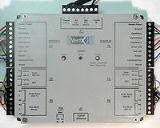
IP access controller
Encyclopedia
IP access controller is an electronic security device designed to identify users and control entry to or exit from protected areas. A typical IP access controller supports 2 or 4 basic access control readers. It may have an internal web server and support configuration via a browser or via software installed on a host PC.
The main features that distinguish IP controllers from older generation of serial controllers are:
1. IP controllers connect directly to LAN/WAN and have all the inputs and outputs necessary for controlling readers, monitoring door inputs and controlling locks.
2. IP controllers have an on-board network interface and does not require the use of a terminal server
.
Examples of IP access controllers are GC01n by Simac/SimacQuadCore, PAC-512-IP by PAC/Stanley Security Products, DirectDoor by GE Security Products and VertX V2000 by HID Global.
Disadvantages:
Considering the above fact SOLUS has developed the controller with both the Options to allow the users to choose the IP or serial
The main features that distinguish IP controllers from older generation of serial controllers are:
1. IP controllers connect directly to LAN/WAN and have all the inputs and outputs necessary for controlling readers, monitoring door inputs and controlling locks.
2. IP controllers have an on-board network interface and does not require the use of a terminal server
Terminal server
A terminal server enables organizations to connect devices with an RS-232, RS-422 or RS-485 serial interface to a local area network . Products marketed as terminal servers can be very simple devices that do not offer any security functionality, such as data encryption and user authentication...
.
Examples of IP access controllers are GC01n by Simac/SimacQuadCore, PAC-512-IP by PAC/Stanley Security Products, DirectDoor by GE Security Products and VertX V2000 by HID Global.
Advantages and disadvantages of IP controllers
Advantages:- An existing network infrastructure is fully utilized; there is no need to install new communication lines.
- There are no limitations regarding the number of IP controllers in a system (the limit of 32 controllers per line is typical for systems using RS-485 communication interface).
- Special knowledge of installation, termination, grounding and troubleshooting of RS-485 communication lines is not required.
- Communication with IP controllers may be done at the full network speed, which is important if transferring a lot of data (databases with thousands of users, possibly including biometric records).
- In case of an alarm IP controllers may initiate connection to the host PC. This ability is important in large systems as it allows reducing network traffic generated by frequent polling.
- Simplifies installation of systems consisting of multiple locations separated by large distances. Basic Internet link is sufficient to establish connections to remote locations.
- Wide selection of standard network equipment is available to provide connectivity in different situations (fiber, wireless, VPN, dual path, PoE)
- No special hardware is required for building fail-over systems: in case the primary host PC fails, the secondary host PC may start polling IP controllers.
Disadvantages:
- The system becomes susceptible to network related problems, such as delays in case of heavy traffic and network equipment failures.
- IP controllers and workstations may become accessible to hackers if the network of an organization is not well protected. This threat may be eliminated by physically separating the access control network from the network of the organization. Also most IP controllers utilize either Linux platform or proprietary operating systems, which makes them more difficult to hack. Industry standard data encryption is also used.
- Maximum distance from a hub or a switch to the controller is 100 meters (330 feet).
- Operation of the system is dependent on the host PC. In case the host PC fails, events from IP controllers are not retrieved and functions that require interaction between readers (i.e. anti-passback) stop working. Some controllers, however, have peer-to-peer communication option in order to reduce dependency on the host PC.
- Unlike IP readers, most IP controllers do not support PoE. This, however, may change if the PoE technology is improved to deliver more power, or low-power controllers and locks are introduced. Based on the current PoE standards power that can be carried by a single network cable is enough for one IP reader and an electric strike or a magnetic lock, but connecting an IP controller and 2 or more electric locks would require more power than available via PoE.
Considering the above fact SOLUS has developed the controller with both the Options to allow the users to choose the IP or serial

